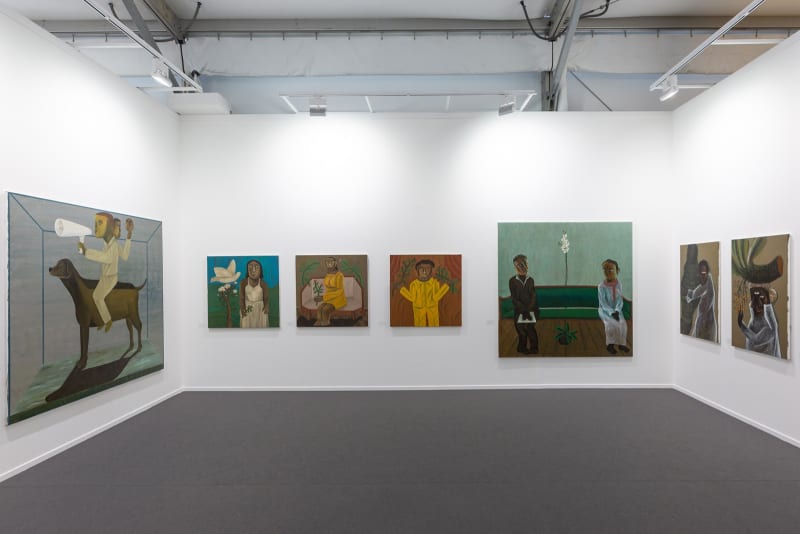Excitement surrounds first big fair of Covid era after months of cancellations and online-only events
Within 10 minutes of Art Dubai opening, Meem Gallery had sold three etchings by the late renowned Syrian painter Marwan — a sign of the pent-up demand and excitement surrounding one of the first established international art fairs of the Covid era.
This week, after months of cancellations and online-only events in the art world, a downsized, Covid-secure Art Dubai welcomed visitors to three tents in the United Arab Emirates’ tourist hotspot.
“This is huge for the art scene. Art Dubai is at the heart of the cultural sector in the UAE — we all really needed this,” said Charlie Pocock of Meem Gallery. “They achieved the possible out of the impossible.”
The fair, now in its 15th year, has been central to establishing Dubai as a commercial hub for contemporary art but was cancelled last year because of the coronavirus.
This week’s event, which will end on Saturday, is the city’s latest attempt to revive its position as a commercial and tourist hub as it races ahead with a successful vaccination campaign. The winter sun of Dubai, one of the most open cities in the world since it came out of a strict lockdown last May, has attracted temporary residents, from bankers to tech bros, looking to escape lockdowns elsewhere.
The emirate became a mass-market tourist destination over the new year, triggering a sharp spike in cases and hospitalisations. This second wave is receding but with new case numbers higher than the UK and US on a per capita basis, holding an in-person art fair was a gamble.
All exhibitors and staff had to take a PCR test before the fair opened. Security enforced reduced capacity, with 18,000 visits expected compared with 28,000 in 2019. There were 50 booths, compared to the usual 85, and, as an incentive, galleries only paid their stand rental if they achieved sales. By Friday, the fair was on track to receive the booth fees in full.
“It was not without its risks but we were always confident the fair would be a success,” said Ben Floyd, the event’s co-founder. “This payment system is a one-off because of the pandemic, but I expect an element of this will continue in the future.”
Attending the opening on Monday was the usual throng of bespectacled hipsters, artificially sculpted ladies-who-lunch and bankers in suits without ties. There was universal excitement about the return of in-person art buying. “We are the resistance against corona,” said Ali Jaber, a Dubai-based journalist and a judge on Arabs Got Talent, a TV show.
There were overseas collectors from Russia, India and Spain — though British visitors were conspicuous by their absence. Since February, UK nationals and residents returning from the UAE have had to spend 10 days in hotel quarantine at a cost of £1,750.
London-based Lorenzo Ronchini said he would avoid hotel quarantine by staying over in his native Italy before returning to his Mayfair gallery. “But for me, being at the fair is so important to get new clients, I would have done the hotel quarantine if I had to,” he said.
The emirate remains a magnet for artists and collectors from Asia through to Africa. “It’s important for the gallery to look east across the Indian Ocean, rather than always to Europe or America,” said Danda Jaroljmek, founder of Nairobi’s Circle Art Gallery. Sales at her gallery have quadrupled since September thanks to collectors having spare time through lockdowns, she said.
Paris-based gallerist Emmanuel Perrotin had spent some of the winter on holiday in Dubai. Having attended 24 fairs in 2019 and just four last year, Art Dubai is his first outing of 2021. “We enjoyed the life here, and with Paris shut down, I am very excited to do the fair,” he said, under one of Takashi Murakami’s flower paintings, estimated for sale at around $500,000.
Perrotin has seen first hand how interest in art has grown since first attending Art Dubai, a joint venture between private owners and the Dubai International Financial Centre, in 2009. The city now boasts creative districts such as Alserkal Avenue and a contemporary museum, the Jameel Arts Centre. “Dubai has changed,” Perrotin said. “We have met a lot of people here with a great interest — contemporary art has bigger recognition now.”
The fair also attracted a new breed of collector, digital natives prone to proselytising the latest phenomenon: NFTs (non-fungible tokens), works of digital art verified by blockchain technology.
As collectors wandered the halls of Art Dubai, NFT enthusiasts joined an inaugural crypto-art cruise, where new works were displayed by UAE-based banker-turned-NFT artist Amrita Sethi, Playmate of the Year Debby Gommeren and Sophia the robot.
Many “digital nomads” are in Dubai, according to the cruise sponsor, crypto-veteran Joel Dietz, who plans to make the city his primary residence. The eye-watering sales prices raised by digital practitioners, fuelled by the soaring value of cryptocurrencies, has persuaded established artists to jump on the bandwagon, including Damien Hirst. A digital work by artist Beeple sold at auction for $69.3m last month.
Back at Art Dubai, exhibitors say the fair is a testament to the city's diversity. “This show represents the Philippines in a different way, battling the stereotype of a big exporter of foreign labour into the Gulf,” said Chris Fussner of the Cebu-based exhibitor Tropical Futures Institute. “It’s nice to represent us culturally in the contemporary scene.”
